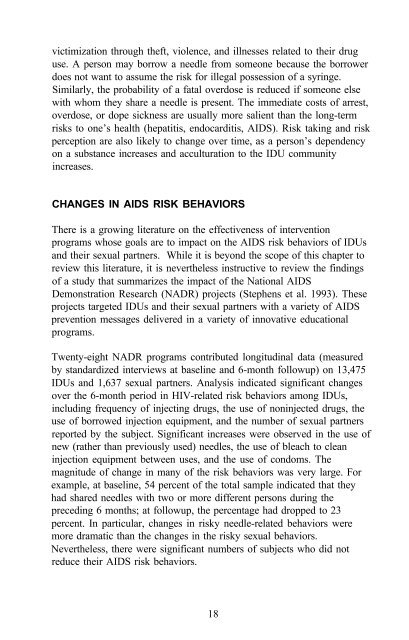The Context of HIV Risk Among Drug Users and Their Sexual Partners
The Context of HIV Risk Among Drug Users and Their Sexual Partners
The Context of HIV Risk Among Drug Users and Their Sexual Partners
You also want an ePaper? Increase the reach of your titles
YUMPU automatically turns print PDFs into web optimized ePapers that Google loves.
victimization through theft, violence, <strong>and</strong> illnesses related to their drug<br />
use. A person may borrow a needle from someone because the borrower<br />
does not want to assume the risk for illegal possession <strong>of</strong> a syringe.<br />
Similarly, the probability <strong>of</strong> a fatal overdose is reduced if someone else<br />
with whom they share a needle is present. <strong>The</strong> immediate costs <strong>of</strong> arrest,<br />
overdose, or dope sickness are usually more salient than the long-term<br />
risks to one’s health (hepatitis, endocarditis, AIDS). <strong>Risk</strong> taking <strong>and</strong> risk<br />
perception are also likely to change over time, as a person’s dependency<br />
on a substance increases <strong>and</strong> acculturation to the IDU community<br />
increases.<br />
CHANGES IN AIDS RISK BEHAVIORS<br />
<strong>The</strong>re is a growing literature on the effectiveness <strong>of</strong> intervention<br />
programs whose goals are to impact on the AIDS risk behaviors <strong>of</strong> IDUs<br />
<strong>and</strong> their sexual partners. While it is beyond the scope <strong>of</strong> this chapter to<br />
review this literature, it is nevertheless instructive to review the findings<br />
<strong>of</strong> a study that summarizes the impact <strong>of</strong> the National AIDS<br />
Demonstration Research (NADR) projects (Stephens et al. 1993). <strong>The</strong>se<br />
projects targeted IDUs <strong>and</strong> their sexual partners with a variety <strong>of</strong> AIDS<br />
prevention messages delivered in a variety <strong>of</strong> innovative educational<br />
programs.<br />
Twenty-eight NADR programs contributed longitudinal data (measured<br />
by st<strong>and</strong>ardized interviews at baseline <strong>and</strong> 6-month followup) on 13,475<br />
IDUs <strong>and</strong> 1,637 sexual partners. Analysis indicated significant changes<br />
over the 6-month period in <strong>HIV</strong>-related risk behaviors among IDUs,<br />
including frequency <strong>of</strong> injecting drugs, the use <strong>of</strong> noninjected drugs, the<br />
use <strong>of</strong> borrowed injection equipment, <strong>and</strong> the number <strong>of</strong> sexual partners<br />
reported by the subject. Significant increases were observed in the use <strong>of</strong><br />
new (rather than previously used) needles, the use <strong>of</strong> bleach to clean<br />
injection equipment between uses, <strong>and</strong> the use <strong>of</strong> condoms. <strong>The</strong><br />
magnitude <strong>of</strong> change in many <strong>of</strong> the risk behaviors was very large. For<br />
example, at baseline, 54 percent <strong>of</strong> the total sample indicated that they<br />
had shared needles with two or more different persons during the<br />
preceding 6 months; at followup, the percentage had dropped to 23<br />
percent. In particular, changes in risky needle-related behaviors were<br />
more dramatic than the changes in the risky sexual behaviors.<br />
Nevertheless, there were significant numbers <strong>of</strong> subjects who did not<br />
reduce their AIDS risk behaviors.<br />
18
















